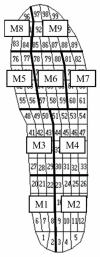Effects of Rearfoot Eversion on Foot Plantar Pressure and Spatiotemporal Gait Parameters in Adolescent Athletes
- PMID: 37444676
- PMCID: PMC10340695
- DOI: 10.3390/healthcare11131842
Effects of Rearfoot Eversion on Foot Plantar Pressure and Spatiotemporal Gait Parameters in Adolescent Athletes
Abstract
Background: Foot malalignment can augment the risk of lower-extremity injuries and lead to musculoskeletal disorders. This study aimed to clarify the contribution of rearfoot alignment to plantar pressure distribution and spatiotemporal parameters during gait in healthy adolescent athletes.
Methods: This retrospective study included 39 adolescent athletes who were divided into the rearfoot eversion and control groups according to a leg heel angle of 7°. A total of 78 legs were analyzed (45 and 33 legs in the rearfoot eversion [women, 53.3%] and control groups [women, 48.5%], respectively). Gait was assessed using an in-shoe plantar pressure measuring system and a wearable inertial sensor.
Results: The foot plantar pressure distribution in the hallux was higher in the rearfoot eversion group than that in the control group (p = 0.034). Spatiotemporal parameters showed that the foot pitch angle at heel strike was significantly larger in the rearfoot eversion group than that in the control group (24.5° vs. 21.7°; p = 0.015). Total sagittal range of motion of the ankle during the stance phase of gait was significantly larger in the rearfoot eversion group than that in the control group (102.5 ± 7.1° vs. 95.6 ± 15.8°; p = 0.020). Logistic regression analysis revealed that plantar pressure at the hallux and medial heel and foot pitch angle at heel strike were significantly associated with rearfoot eversion.
Conclusions: Our findings suggest that rearfoot eversion affects the gait patterns of adolescent athletes. Notably, leg heel angle assessment, which is a simple and quick procedure, should be considered as an alternative screening tool for estimating plantar pressure and spatiotemporal gait parameters to prevent sports-related and overuse injuries in adolescent athletes.
Keywords: adolescent athlete; foot morphology; gait; plantar foot pressure; rearfoot eversion; spatiotemporal gait analysis.
Conflict of interest statement
The authors declare no conflict of interest.
Figures
Similar articles
-
The effect of changing mediolateral center of pressure on rearfoot eversion during treadmill running.Gait Posture. 2021 Jan;83:201-209. doi: 10.1016/j.gaitpost.2020.10.032. Epub 2020 Nov 3. Gait Posture. 2021. PMID: 33171373
-
Can orthotic wedges change the lower-extremity and multi-segment foot kinematics during gait in people with plantar fasciitis?Gait Posture. 2022 Sep;97:174-183. doi: 10.1016/j.gaitpost.2022.07.259. Epub 2022 Aug 2. Gait Posture. 2022. PMID: 35964335 Clinical Trial.
-
Step width modification to change rearfoot eversion and medial longitudinal arch angle during walking and running in individuals with pronated feet.Gait Posture. 2024 Sep;113:366-373. doi: 10.1016/j.gaitpost.2024.07.295. Epub 2024 Jul 26. Gait Posture. 2024. PMID: 39068870
-
Biomechanical Factors Associated With Achilles Tendinopathy and Medial Tibial Stress Syndrome in Runners.Am J Sports Med. 2017 Sep;45(11):2614-2621. doi: 10.1177/0363546517708193. Epub 2017 Jun 5. Am J Sports Med. 2017. PMID: 28581815
-
Gait retraining targeting foot pronation: A systematic review and meta-analysis.PLoS One. 2024 Mar 1;19(3):e0298646. doi: 10.1371/journal.pone.0298646. eCollection 2024. PLoS One. 2024. PMID: 38427634 Free PMC article.
Cited by
-
Foot Posture Index Does Not Correlate with Dynamic Foot Assessment Performed via Baropodometric Examination: A Cross-Sectional Study.Healthcare (Basel). 2024 Apr 10;12(8):814. doi: 10.3390/healthcare12080814. Healthcare (Basel). 2024. PMID: 38667576 Free PMC article.
-
Long term gait postural characteristics of children with general foot pain using smartphone connected wearable sensors.Sci Rep. 2025 Mar 5;15(1):7767. doi: 10.1038/s41598-025-91374-5. Sci Rep. 2025. PMID: 40044724 Free PMC article.
-
The Effect of Weight Distribution in the Foot on Balance and Plantar Pressure in Female Adolescent Athletes.Sports Health. 2024 Sep 11:19417381241277796. doi: 10.1177/19417381241277796. Online ahead of print. Sports Health. 2024. PMID: 39258652 Free PMC article.
References
-
- Prieto-Gonzalez P., Martinez-Castillo J.L., Fernandez-Galvan L.M., Casado A., Soporki S., Sanchez-Infante J. Epidemiology of Sports-Related Injuries and Associated Risk Factors in Adolescent Athletes: An Injury Surveillance. Int. J. Environ. Res. Public Health. 2021;18:4857. doi: 10.3390/ijerph18094857. - DOI - PMC - PubMed
Grants and funding
LinkOut - more resources
Full Text Sources



